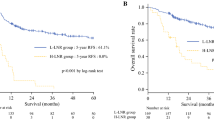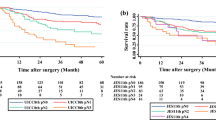Abstract
Background
Lymph node status is an important factor in determining preoperative treatment strategies for stage T1b–T2 esophageal cancer (EC). Thus, the aim of this study was to investigate the risk factors for lymph node metastasis (LNM) in T1b–T2 EC and to establish and validate a risk-scoring model to guide the selection of optimal treatment options.
Methods
Patients who underwent upfront surgery for pT1b–T2 EC between January 2016 and December 2022 were analyzed. On the basis of the independent risk factors determined by multivariate logistic regression analysis, a risk-scoring model for the prediction of LNM was constructed and then validated. The area under the receiver operating characteristic curve (AUC) was used to assess the discriminant ability of the model.
Results
The incidence of LNM was 33.5% (214/638) in our cohort, 33.4% (169/506) in the primary cohort and 34.1% (45/132) in the validation cohort. Multivariate analysis confirmed that primary site, tumor grade, tumor size, depth, and lymphovascular invasion were independent risk factors for LNM (all P < 0.05), and patients were grouped based on these factors. A 7-point risk-scoring model based on these variables had good predictive accuracy in both the primary cohort (AUC, 0.749; 95% confidence interval 0.709–0.786) and the validation cohort (AUC, 0.738; 95% confidence interval 0.655–0.811).
Conclusion
A novel risk-scoring model for lymph node metastasis was established to guide the optimal treatment of patients with T1b–T2 EC.


Similar content being viewed by others
References
Bray F, Ferlay J, Soerjomataram I, Siegel RL, Torre LA, Jemal A (2018) Global cancer statistics 2018: GLOBOCAN estimates of incidence and mortality worldwide for 36 cancers in 185 countries. CA Cancer J Clin 68(6):394–424
Sjoquist KM, Burmeister BH, Smithers BM, Zalcberg JR, Simes RJ, Barbour A et al (2011) Survival after neoadjuvant chemotherapy or chemoradiotherapy for resectable oesophageal carcinoma: an updated meta-analysis. Lancet Oncol 12(7):681–692
van Hagen P, Hulshof MC, van Lanschot JJ, Steyerberg EW, van Berge HM, Wijnhoven BP et al (2012) Preoperative chemoradiotherapy for esophageal or junctional cancer. N Engl J Med 366(22):2074–2084
Ajani JA, D’Amico TA, Bentrem DJ, Chao J, Corvera C, Das P et al (2019) Esophageal and esophagogastric junction cancers, version 2.2019, NCCN clinical practice guidelines in oncology. J Natl Compr Canc Netw 17(7):855–83
Ancona E, Rampado S, Cassaro M, Battaglia G, Ruol A, Castoro C et al (2008) Prediction of lymph node status in superficial esophageal carcinoma. Ann Surg Oncol 15(11):3278–3288
Markar SR, Gronnier C, Pasquer A, Duhamel A, Behal H, Théreaux J et al (2017) Discrepancy between clinical and pathologic nodal status of esophageal cancer and impact on prognosis and therapeutic strategy. Ann Surg Oncol 24(13):3911–3920
Shin S, Kim HK, Choi YS, Kim K, Shim YM (2014) Clinical stage T1–T2N0M0 oesophageal cancer: accuracy of clinical staging and predictive factors for lymph node metastasis. Eur J Cardiothorac Surg 46(2):274–279
Foley KG, Christian A, Fielding P, Lewis WG, Roberts SA (2017) Accuracy of contemporary oesophageal cancer lymph node staging with radiological-pathological correlation. Clin Radiol 72(8):691–693
Takizawa K, Matsuda T, Kozu T, Eguchi T, Kato H, Nakanishi Y et al (2009) Lymph node staging in esophageal squamous cell carcinoma: a comparative study of endoscopic ultrasonography versus computed tomography. J Gastroenterol Hepatol 24(10):1687–1691
Yamada H, Hosokawa M, Itoh K, Takenouchi T, Kinoshita Y, Kikkawa T et al (2014) Diagnostic value of 18F-FDG PET/CT for lymph node metastasis of esophageal squamous cell carcinoma. Surg Today 44(7):1258–1265
Dave SS, Wright G, Tan B, Rosenwald A, Gascoyne RD, Chan WC et al (2004) Prediction of survival in follicular lymphoma based on molecular features of tumor-infiltrating immune cells. N Engl J Med 351(21):2159–2169
Wang J, Chen S, Zhong F, Zhu T, Zhao Y (2023) A LASSO-derived prediction model for assessing the risk of lymph node metastasis in T1 and T2 epithelial ovarian cancer: an international retrospective cohort study. Int J Surg. https://doi.org/10.1097/JS9.0000000000000065
Wu J, Chen QX, Shen DJ, Zhao Q (2018) A prediction model for lymph node metastasis in T1 esophageal squamous cell carcinoma. J Thorac Cardiovasc Surg 155(4):1902–1908
Zhou Y, Du J, Wang Y, Li H, Ping G, Luo J et al (2019) Prediction of lymph node metastatic status in superficial esophageal squamous cell carcinoma using an assessment model combining clinical characteristics and pathologic results: a retrospective cohort study. Int J Surg 66:53–61
Amin MB, Edge SB, Greene FL et al (2016) AJCC Cancer Staging Manual. In: Amin MB, Edge SB, Greene FL et al (eds) Organization of the AJCC cancer staging manual, 8th edn. Springer, New York, p 20320
Cai F, Dong Y, Wang P, Zhang L, Yang Y, Liu Y et al (2022) Risk assessment of lymph node metastasis in early gastric cancer: establishment and validation of a seven-point scoring model. Surgery 171(5):1273–1280
Sullivan LM, Massaro JM, D’Agostino RS (2004) Presentation of multivariate data for clinical use: the Framingham study risk score functions. Stat Med 23(10):1631–1660
Mariette C, Piessen G, Briez N, Triboulet JP (2008) The number of metastatic lymph nodes and the ratio between metastatic and examined lymph nodes are independent prognostic factors in esophageal cancer regardless of neoadjuvant chemoradiation or lymphadenectomy extent. Ann Surg 247(2):365–371
Tian D, Jiang KY, Huang H, Jian SH, Zheng YB, Guo XG et al (2020) Clinical nomogram for lymph node metastasis in pathological T1 esophageal squamous cell carcinoma: a multicenter retrospective study. Ann Transl Med 8(6):292
Zheng H, Tang H, Wang H, Fang Y, Shen Y, Feng M et al (2018) Nomogram to predict lymph node metastasis in patients with early oesophageal squamous cell carcinoma. Br J Surg 105(11):1464–1470
Newton AD, Predina JD, Xia L, Roses RE, Karakousis GC, Dempsey DT et al (2018) Surgical management of early-stage esophageal adenocarcinoma based on lymph node metastasis risk. Ann Surg Oncol 25(1):318–325
Qi Y, Wu S, Tao L, Xu G, Chen J, Feng Z et al (2021) A population-based study: how to identify high-risk T1–2 esophageal cancer patients? Front Oncol 11:766181
Wang Y, Zhu L, Xia W, Wang F (2018) Anatomy of lymphatic drainage of the esophagus and lymph node metastasis of thoracic esophageal cancer. Cancer Manag Res 10:6295–6303
Li DL, Zhang L, Yan HJ, Zheng YB, Guo XG, Tang SJ et al (2022) Machine learning models predict lymph node metastasis in patients with stage T1–T2 esophageal squamous cell carcinoma. Front Oncol 12:986358
Kienle P, Buhl K, Kuntz C, Düx M, Hartmann C, Axel B et al (2002) Prospective comparison of endoscopy, endosonography and computed tomography for staging of tumours of the oesophagus and gastric cardia. Digestion 66(4):230–236
Lerut T, Flamen P, Ectors N, Van Cutsem E, Peeters M, Hiele M et al (2000) Histopathologic validation of lymph node staging with FDG-PET scan in cancer of the esophagus and gastroesophageal junction: a prospective study based on primary surgery with extensive lymphadenectomy. Ann Surg 232(6):743–752
Flamen P, Lerut A, Van Cutsem E, De Wever W, Peeters M, Stroobants S et al (2000) Utility of positron emission tomography for the staging of patients with potentially operable esophageal carcinoma. J Clin Oncol 18(18):3202–3210
Kramer AA, Zimmerman JE (2007) Assessing the calibration of mortality benchmarks in critical care: the Hosmer–Lemeshow test revisited. Crit Care Med 35(9):2052–2056
Chen H, Wang X, Shao S, Zhang J, Tan X, Chen W (2022) Value of EUS in determining infiltration depth of early carcinoma and associated precancerous lesions in the upper gastrointestinal tract. Endosc Ultrasound 11(6):503–510
Cen P, Hofstetter WL, Lee JH, Ross WA, Wu TT, Swisher SG et al (2008) Value of endoscopic ultrasound staging in conjunction with the evaluation of lymphovascular invasion in identifying low-risk esophageal carcinoma. Cancer Am Cancer Soc 112(3):503–510
Funding
This study was supported by the Science and Technology Program of Fujian Province, China (2021J01442).
Author information
Authors and Affiliations
Contributions
J-PL, S-YL, FW, and X-FC: contributed to the conception and design. J-PL, W-JC, P-YW, HZ, and F-NZ: collected and analyzed the data. J-PL, Y-JC, W-WW, and HH: drew the figures and tables. J-PL: wrote the draft. J-PL, W-JC, FW, and S-YL: contributed to manuscript writing and revision. All authors read and approved the final manuscript.
Corresponding authors
Ethics declarations
Disclosures
Authors Jun-Peng Lin, Xiao-Feng Chen, Wei-Jie Chen, Pei-Yuan Wang, Hao He, Feng-Nian Zhuang, Hang Zhou, Yu-Jie Chen, Wen-Wei Wei, Shuo-Yan Liu, and Feng Wang have no conflicts of interest or financial ties to disclose.
Additional information
Publisher's Note
Springer Nature remains neutral with regard to jurisdictional claims in published maps and institutional affiliations.
Supplementary Information
Below is the link to the electronic supplementary material.
Rights and permissions
Springer Nature or its licensor (e.g. a society or other partner) holds exclusive rights to this article under a publishing agreement with the author(s) or other rightsholder(s); author self-archiving of the accepted manuscript version of this article is solely governed by the terms of such publishing agreement and applicable law.
About this article
Cite this article
Lin, JP., Chen, XF., Chen, WJ. et al. Construction and validation of a risk-scoring model to predict lymph node metastasis in T1b–T2 esophageal cancer. Surg Endosc 38, 640–647 (2024). https://doi.org/10.1007/s00464-023-10565-1
Received:
Accepted:
Published:
Issue Date:
DOI: https://doi.org/10.1007/s00464-023-10565-1




